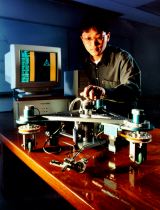
SCOOTER THE COBOT (WITHOUT
THE EYEGLASSES) AND A FRIEND
By Adam Sternbergh

SCOOTER THE COBOT (WITHOUT
THE EYEGLASSES) AND A FRIEND
The introduction of robots into the workplace once sparked fears that the machines would replace half the workers and then go berserk and kill the other half. But a research team at Northwestern University in Illinois is putting such fears to rest with the "cobot" -a motorless robot that works collaboratively with humans to make people's jobs easier. Unlike conventional robots, cobots are entirely reliant on their flesh-and-blood operators for propulsion and control. "Cobots simply can't move on their own," says coinventor J. Edward Colgate, who unveiled the cobot at a mechanical engineering congress in Atlanta in November 1996. "So cobots can work safely with people and yet you'll never see them replacing people."
One of the cobot prototypes, a simple three-wheeler named "Scooter," demonstrates the principle behind these machines. In one mode, Scooter can be pushed by a human operator in any direction along the floor. But Scooter's movements can also be limited to a specific area by programming boundaries into its controlling software-creating "virtual" walls where no physical walls exist.
What is the point? Take auto workers, for example. Auto workers often have to fit heavy, unwieldy components - such as seats or windshields - into tight spaces. Enter the cobots. With the aid of a cobot programmed to move only within a computer-defined "funnel," the operator can easily slide, say, a bulky instrument panel into the cab of a truck without worrying about damaging the truck's frame.
Cobots may soon evolve to perform more exotic applications: Colgate and the cobot's other inventor, Michael Peshkin, are currently designing an arm-shaped cobot that may be used to guide a doctor's hand during delicate, computer-assisted surgery. Goals for Scooter and his less sophisticated cobot friends include cutting down on workplace injuries and pumping up productivity.
General Motors Foundation is banking on Scooter and other cobots reaching these goals; it funded the project and plans to have more complex cobots - now in development - on assembly lines by the end of 1997. Then the important question arises: can Scooter join his coworkers for a beer after work?